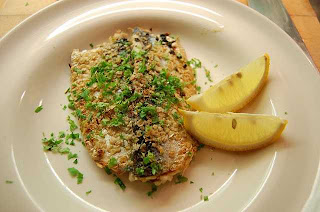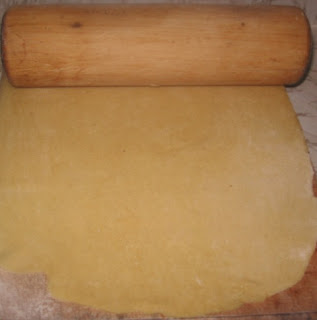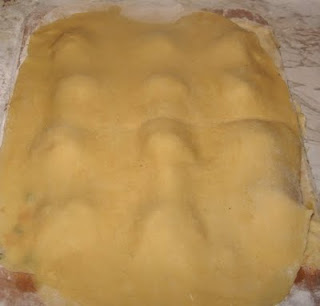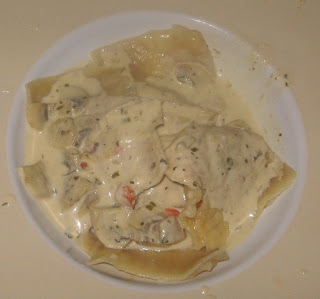Advertisement
If you have a new account but are having problems posting or verifying your account, please email us on hello@boards.ie for help. Thanks :)
Hello all! Please ensure that you are posting a new thread or question in the appropriate forum. The Feedback forum is overwhelmed with questions that are having to be moved elsewhere. If you need help to verify your account contact hello@boards.ie
Hi all,
Vanilla are planning an update to the site on April 24th (next Wednesday). It is a major PHP8 update which is expected to boost performance across the site. The site will be down from 7pm and it is expected to take about an hour to complete. We appreciate your patience during the update.
Thanks all.
Vanilla are planning an update to the site on April 24th (next Wednesday). It is a major PHP8 update which is expected to boost performance across the site. The site will be down from 7pm and it is expected to take about an hour to complete. We appreciate your patience during the update.
Thanks all.
The Random Recipe Thread
Options
Comments
-
Combining two items which formed a staple of the Scottish crofters diet over many centuries, herring coated in oats is a traditional, tasty, nourishing dish rich in Omega Oils. These two ingredients would have also been staples in Connemara, although I don't think they were used together in this part of the world.
Herring are an under-rated fish, healthy, commonly available and economical.
They are also one of the most environmentally responsible species.
This quick and easy meal is without doubt one of the simplest and tastiest meals to cook, great with salad and soda bread or new potatos later in the year. If you are lucky enough to have them, mashed jeruselem artichokes are great with this dish Ingredients:
Allow 2 herrings per person
Rolled Oats - unsweetend like Flahavans porrage oatlets.
Salt and pepper
Knob of butter
Method:
Cut along the underside of the herring, lay it on a table, cut side down and hit across the backbone in a few places with a rolling pin or your hand.
Remove the backbone and as many of the smaller bones as possible.
Scrape the scales from the fish with a knife, remove heads and tails.
Sprinkle with salt and pepper and either toss them in a plastic bag with plenty of rolled oats or put the fish on a plate and coat them with oatmeal - you may have to press the oats into the fish to ensure it is fully covered.
Put a knob of butter in the pan - cooking oil or dripping also work - put them in with the skin side upwards first.
Fry until lightly brown, turn and cook the other side. It should take 5/7 minutes.
Drain the fish on kitchen paper (paper towels).
I'd suggest serving with lemon and parsley - old Scots would not have known such refinements!0 -
Again, being in Holland visiting, I go back to the old North Sea / Baltic staple.
This is basically a Scandinavian dish adapted for more Irish style ingredients.
I'll get some photos up on the blog later later when I can.
One thing we love with our fish is the sharp tang of citrus like lemon, so the buttermilk and mustard sauce gives that flavour.
This is a simple dish, get the potatoes down when you turn on the oven to pre-heat, and put the beans in a steamer about 5 minutes before the fish are done.
Takes about 25 - 30 minutes to cook if the fish are pre-cleaned.
ingredients (serves 2)
4 large herrings
cooking oil[
for the sauce
3 tbsp (1 1/2 oz) 40 g butter
30 g (about a 1/4 teacup (1 oz)) plain flour
300 ml (1/2 pint) buttermilk
1 tablespoon Dijon wholegrain mustard
salt and freshly ground black pepper
* Some sugar or honey on standby (see note)
parsley and lemon wedges, for garnish
method
1. Heat the oven to 200°C (400 F) gas mark 6 and butter a deep ovenproof dish. Remove the heads from the fish, clean, gut, scale and bone them. Rinse and pat dry.
2. Slash the skins diagonally with a sharp knife two or three times on each side. Brush with a little oil. Put the herrings in the dish, cover and bake in the oven for about 20 minutes, until the flesh is no longer pinky.
3. Meanwhile, make the sauce. Melt the butter in a saucepan, stir in the flour and cook for a minute. Gradually blend in the milk, stirring. Add the mustard and bring to the boil slowly, stirring until thickened. Season to taste.
* While tasting, if you find the sauce too sharp add sugar or honey to sweeten slightly
4. Serve the herrings with the sauce poured over, I plated up with some potatoes and buttered green beans.0 -
Like the sound of the sauce, maybe throw this into one of the recipe threads though? There's one for random recipes in the cooking club!0
-
Anyone actually know were on the East Coast you can get Herrings? I tried Howth and was basically told they make more money in Spain.0
-
OK - I have been cooking a lot of herring recently, but one thing I overlooked was the roe.
Most people throw it away, but doing so is a waste as you buy fish by weight and it is delicious.
When you clean the fish, the females have two large roes, or egg sac's, in the abdominal cavity. They are a dark red - like the colour of liver.
Males have white, fatty looking sacs in the same area. These are not to be used for this recipe.
They are worth keeping, as this makes a great breakfast treat or starter.
Had it yesterday as a starter, but forgot to take photo's
INGREDIENTS
500g soft herring roe
2 tbsp plain flour
sea salt and freshly-ground black pepper, to taste
50g Cuinneog butter
1 tsp lemon juice
A few drops of Tabasco sauce
A good pinch of paparika
2 slices wholewheat toast, liberally buttered
Method:
Place the roes in a colander or sieve and pour boiling water over the top.
Dry with kitchen paper.
Season the flour with salt and freshly-ground black pepper. Use a fair bit.
Toss the roes in the flour before and set aside .
Melt the butter in a pan and when foaming add the roes along with the lemon juice and Tabasco sauce and fry for between three and five minutes, or until dry, almost crispy.
In the meantime prepare the toast. Butter it generously.
Cut into triangles, then spoon the cooked onto the toast.
I like to sprinkle over some sliced shallots.
Garnish with a pinch of paprika and serve with a little dressed salad.0 -
Advertisement
-
Where did you get the herring? I'd love some but it's years since I've seen it in the shops here in Dublin.0
-
-
-
-
This recipe I developed to stretch lobster also works well with crab as a much cheaper alternative, and is just as delicious.
Quite simply, the whole concept of a kitchen garden is to deal with what you have at hand, and what is available.
Dont forget to retain all the shells left over as a base for bisque or chowder.
Lobster, an utterly delicious food, but ridiculously expensive. Lobster, for me, is a very welcome gift from local fishermen, and it normally comes around Easter or Christmas.
So, with a little imagination, two small lobsters can go a long way - and produce a rich, warm meal rather than a salad.
This recipe can also be done as a pasta sauce, stretching the lobster even further.
The thing is, we have been conditioned to serve the food on the shell with a salad and a light sauce, and that is perfect if you can afford it - but if your feeding more than 4 a half lobster each, then it gets very pricey very quick.
It could not be simpler, you do not need a pasta machine you might use 6 times a year, all you need is a rolling pin.
2 cups flour
2 large eggs, whole
1/4 cup extra virgin olive oil
1/2 tsp. sea salt
3 tablespoons water
Put all the ingredients in a food processor and process for 30 seconds.
Check consistency and add a small amount of flour is pasta is too wet, or a small amount of water if pasta is too dry. Whizz for another 30 seconds to incorporate any additions.2 lobsters (1 1/2 to 2 pounds each)
Turn dough out onto a pastry board, large chopping board or work surface sprinkled lightly with flour and knead by hand for a minute or two, until smooth.
Place the dough under a bowl to rest for 20 minutes before rolling, or refrigerate, tightly wrapped in plastic and stored in a plastic bag if not using right away.
Use within a few hours for best results.
Roll pasta out. Fold dough over and roll through again, gradually making the pasta thinner as it becomes smoother; dust lightly with flour as needed, but not too much.
It helps to brush off excess flour with a pastry brush.
When pasta is thin enough it is ready for use in making ravioli.
Use the pasta sheets as soon as they are rolled; dry pasta sheets don't seal as well at the edges as fresh sheets, causing the ravioli to separate when cooking.
If your pasta sheets have dried out, brush the edges with an egg wash or water (where the pasta is crimped together).
For this recipe you will need two sheets of pasta. The first one made can be draped over the back of a chair on a clean dishcloth, the second - base layer, can be left on the board - but make sure the board is well floured. You do not want this sticking when you lift.
FOR THE FILLING AND SAUCE
3 tablespoons olive oil
250 ml (1 teacup) white wine
125 ml (1/2 teacup) sherry or Madeira
500 ml (2 teacups) heavy cream
salt
cracked pepper
pinch of cayenne
pinch of nutmeg
Beurre Manie (the uncooked roux - flour/butter paste for white sauce, without the milk as in Galway Gougere recipe)
For Ravioli parcel
Freshly chopped chives
Pinch of paprikaRECOMMENDED EXTRASI love to add a good tablespoon of chopped tarragon to the sauce, it really adds to the flavour.
Recently I also added mussels and cooked them in the sauce, they look fantastic, their dark shells surrounding the ravioli parcels.PROCESS1- kill the lobster** (see footnote)
2- Turn the lobster around and cut the tail and body in half long ways.
Cut the tail into sections.
3- Remove the claws and reserve.
4- Along the center of the lobster are three kinds of viscera, the dark green are the stomach and intestine that can be scraped out and discarded.
The yellow green and red coral are the tomalley and the roe which are delicious and may be left in.COOKING THE LOBSTER TAILHeat the olive oil in a heavy based pan.
Sear all the lobster tail meat pieces until bright red.
Remove lobster tail meat from pan - at this point you can start to de-glaze the pan (see further on) and cook any extra shellfish.FOR THE RAVIOLIMix the cooked lobster tail with the chopped chives and paprika, and place on the ravioli sheet, about a tablespoon per parcel.
If you want extra zing, a little chili or a squeeze of lemon juice can be added.
Again, be sure that the surface under the base pasta sheet is well dusted with flour and will not stick to the work surface. Then apply a light eggwash beween the food clusters and drape over the second sheet. Press down between the food parcels, then using a glass or a cookie cutter cut carefully around them.
Crimp the edges with a fork to seal.
5 minutes before the sauce is ready, drop the ravioli parcels in boiling water. They will float to the surface when cooked.
If you are in any way nervous about the parcels splitting, you can also use a steamer or fish kettle, although this will make the pasta a little dry, but it's still niceFOR THE SAUCEWhile preparing the lobster ravioli packages, put the white wine on the pan to deglaze.
Reduce by half.
If you have mussels, cockles or other shell fish, you can also add these to the wine during the reduction process to cook.
I now always use mussels as it adds to the presentation
When the wine is reduced remove and put aside any extra cooked shellfish.
Add cream, Madeira/Sherry and seasonings, add the lobster claw meat to the pot and cook until the meat is cooked through, about 8 minutes.
Whisk in beurre manie a little at a time until sauce begins to thicken.
Simmer over medium heat for 15 minutes.
Return any extra shellfish 5 minutes from the end of cooking, the same time as you start to cook the ravioli parcels.
Adjust seasonings and serve sauce over cooked ravioli, surrounded by the extra cooked shellfish. This meal is very rich, and very adaptable. If you don't like the idea of making ravioli parcels, use the fresh pasta to make tagliatelle instead, and serve all the lobster meat over the pasta as a sauce, this will stretch the lobster meat even further.
** An illustrated guide to killing the lobster in a humane way is at my garden blog, reader discretion is advised.0 -
Advertisement
-
There are a few very simple dishes that always work well.
Bisque and Moule mariner are two, and by making and freezing shellfish stock, you always have ths at hand - it's simple, tasty and straight forward.
Making the shellfish stock is easy, and also gives you more value for money - and another helpful addition to the garden.
Whenever I have finished with the shells, I put them in the ash grate of a fire.
This way they toast or bake dry. I then break them up coarsely and spread them on the garden pathways. I hope that like egg shells the sharp, broken shell helps in the struggle against slugs and snails, besides, it's a form of recycling and can't do any harm.
The shellfish stock serves as a basis for two fish soups I like to do. The first is the simplest, and a classic Belgian staple - also very popular in the Zeus region of the Netherlands, served on the street every year outside De Mug - one of my favorite pubs in one of my favorite towns in the world.
There are several variations on Moule Mariner, but this one works for me and is pretty true to its Belgian origins but might be better described as a Mussel Bisque with more depth, using shellfish stock.
Quite often the soup in Belgium has additional kick added to it by adding a dash of Pernod, but I just add fennel buld for that same aniseed flavour.
Perfect served with freshly made soda bread. More pictures on the blog.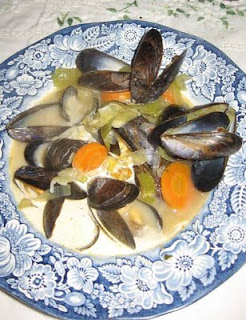
FOR MOULE MARINER
Ingredients:
1 Kilo Mussels
750 ml Shellfish stock*. (See footnote)
3 sticks celery, finely sliced
1 bulb fennel, finely sliced
1 leek, finely sliced.
1 Onion, finely diced.
2 Cloves Garlic finely sliced.
250 ml dry white wine
Parsley to garnish
Cream
Method:
In a heavy based pot, add a knob of butter and heat until foaming.
Add the sliced veg until softened.
Add the wine and mussels, steaming the mussels for 5 minutes - or until open.
Remove the mussels and set aside, add the shellfish stock and bring to the boil.
Return the mussels to the pot and heat up.
Serve in large bowls with a dash of cream and garnish with parsley - serve with soda bread, warm and delicious.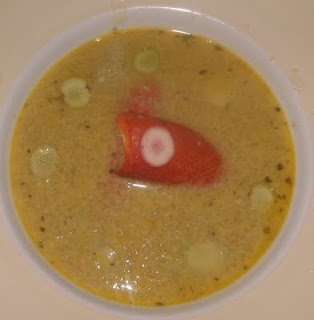
FOR BISQUE
Bisque is just a richer version without the aniseed flavours and contains more meat in the soup.
The mushrooms add richness. Rather than the aniseed flavour of fennel, this gets a kick from cayenne pepper.
Its more a winter/autumn soup than the Moule Mariner.
You can vary it to your own taste of course, one version pictured here was served with lobster shell for decoration and sliced, raw Oca to decorate and to add a citrus style zing to it.
The Oca really works for this recipe, its tart, sharp apple/citrus flavour cuts the richness giving a very nice tang to the meal.
The other photo has cream and lardon crutons.
FOR BISQUE
Knob butter
Handfull button mushrooms.
One onion, finely chopped
One leek, finely sliced
Two good stems chopped celery sticks
One chopped carrot
1 litre shellfish stock*. (See footnote)
teaspoon salt
1/2 (half) teaspoon cayenne pepper
120 ml dry white wine
225 g cooked lobster, prawn, crab or other crustacian meat
Cream
1.Melt the butter in a large saucepan over medium-low heat.
Add the mushrooms, onion, celery, and carrot. Cook and stir until tender, about 10 minutes.
Stir in the shellfish stock, and season with salt and cayenne pepper.
Bring to a boil, then simmer for 10 minutes.
2.Pour the vegetable and broth mixture into the container of a blender,
and add half the crustacian meat.
Cover, and process until smooth.
3. Return to the saucepan, and stir in the cream, white wine, and remaining crustacian meat.
Cook over low heat, stirring frequently until thickened, about 30 minutes.
SHELLFISH STOCK
Very simple and straight forward. Take any shellfish remains, crab claws, lobster, prawn etc and break up.
Cover with cold water, add some salt, pepper, bay leaves, a small onion, small carrot and some celery.
Bring to the boil, simmer for an hour and a half. Allow to cool and strain off liquid.
Shells can be put in the ash drawer of a fire, dried out, broken up and spread on garden paths or veg beds to deter snails and slugs as eggshells are.0 -
A lot of people go to great lengths killing dandelions on their lawn, but I would suggest you let them flower first, then collect before they can run to seed, thus controlling them, and make use of them.
You can always spray with poison afterwards, or go with homemade-organic-garden-chemicals. IMHO cheaper and safer, at least you know whats in it.
This recipe is based on a traditional French jam made with lemon, I use lime as I prefer the zing they have.
There are two varients I make, a jam and a syrup.200 gm (2 teacups) Dandelion heads, the green bit removed
200 ml (2 teacups) boiling water
zest of 1 lime
juice of 1 lime300ml (3 teacups) sugar
1 tsp Pectin (this is already added in jam making sugar)
Place two cups of dandelion heads into a mixing bowl and add the zest of the lime.
Pour two cups of boiling water over.
Leave overnight to infuse.
You can add a few apple peels to help the setting process
After soaking pour the mixture through a sieve to separate all the leaves.
Add the lime juice and bring the mixture to the boil.
Add the sugar and pectin and boil rapidly for 10 minutes, then start checking while it reduces for set point.
After that, pour the mixture into warm sterile jars and waterbath.
Always date and label.
Once opened, consume within one month.
There is another option, by not adding pectin, you can simply reduce the liquid by about 30% and create a lovely syrup for puddings, toast etc. It is delicious.0 -
when you say dandelion heads, not the green bit - do you mean just the yellow petals?0
-
Exactly, thanks for asking - your the second person to do so.
The green parts are bitter, so just the yellow petals0 -
Join Date:Posts: 9538
I am going to remove your access to the forum if you continue to use it to promote your blog. That goes for all you threads/posts.0 -

This is not an expensive meal, smoked fish, potato and eggs are the basis.
The mackerel was sourced from the Connemara Smoke House - eggs from the neighbours.
A few years back I was working in Australia, where I was introduced to Eggs Benedict-or more properly a variation that is common in Australia known as Eggs Montreal or Eggs Royale which substitutes smoked salmon for the ham in the classic dish.
After that I toured New Zealand, and ordered Eggs Royale in the So Hotel in Christchurch, near Tuam street and on Cashel street!
I think my favorite hotel in the world, with a great story behind it
They served their Eggs Royale with a small fillet of smoked salmon cut thickly rather than the usual slices, and I loved it.
The Maltese sauce is another variation on the classic - funny thing is, although I had the sauce in Malta - its actually a French Recipe!
Smoked fish and eggs is a classic combination, salmon and scrambled eggs, kedgeree in Scotland with smoked herring, eggs and rice - there are many examples.
I can't wait until the perennial bed comes up next year so I can use asparagus spears with the mackerel and garnish with samphire - Nevin watch out!!
With that inspiration, I came up with this brunch, with the usual Irish twist - as the mackerel came from Ballyconeeley I'm calling this one Eggs Errislannan
FOR THE MALTESE SAUCE
The Maltese Sauce is the hardest part of the meal to make, but the great thing about it is that you can make it in advance and re-heat.
80ml freshly squeezed orange juice
1 Tsp orange zest
1 duck egg yolk (you can keep the white or chuck in the boxty mix if you like)
230 grams Cuinneog butter (using Cuinneog really adds to the flavour)
1 Tsp dried Tarragon
Good pinch of Cayenne
Melt the butter at a low temperature and keep warm in a bowl. Keep about 2 tsp in reserve for the boxty.
In a small saucepan, combine the orange juice and orange zest, and place over medium-high heat.
Bring the saucepan to a boil and reduce by 2/3, about 3 minutes.
Remove from the heat and strain into a bain marie bowl.
Add the duck egg yolk, Cayenne and Tarragon - whisk.
Set the bowl over a pan of simmering water and continue to whisk until the egg starts to thicken, about 2 to 3 minutes.
Remove the bowl from the heat, and slowly drizzle a little of the butter into the egg mixture.
Whisk constantly to incorporate.
Return the bowl to the heat, whisk again, and when the egg starts to thicken again, continue to add more of the butter to the egg.
Remove from the heat periodically to cool the bowl, and return it once it cools slightly.
Continue in this on-the-heat, off-the-heat fashion until all of the clarified butter is incorporated.
The moment the butter is incorporated remove the bowl from the saucepan, transfer the sauce into a cool sauce boat, and season with the salt and pepper.
=====
As a base for the meal I used buttermilk Boxty, I did try buttermilk whey chapatti, but this gives more depth and richness.
FOR THE BOXTY BASE
250g, peeled, grated, squeezed
250g cold mashed potato
100ml Cuinneog buttermilk
200g plain flour
1 heaped tsp baking powder
1-2 tbsp melted cuinneog butter
salt and freshly ground black pepper
If prepping from scratch, you can also add the duck egg white left over from the maltese sauce.
Wrap the grated potato in a clean tea towel and wring well to get rid of any excess liquid.
Add the grated potato to a mixing bowl with the cold mashed potato and mix until well combined.
Add the flour and baking powder to the potato mixture and mix until well combined.
Stir in the melted butter and season, to taste, with salt and black pepper.
Add the buttermilk, a little at a time, to the potato mixture, beating after each addition until the buttermilk has been fullyworked into the mixture. When all of the buttermilk has been added to the potato mixture it should resemble a thick, heavy batter. If the mixture is too sticky, add more milk as necessary. Set aside.
Heat some oil in a large non-stick frying pan over a medium to high heat.
Around this time its a good time to start poaching the eggs.
Add spoonfuls of the boxty batter to the pan, leaving enough space around each spoonful for the mixture to spread.
Fry the boxties on a medium to high heat for 3-4 minutes on each side, or until the boxties are golden-brown and the grated potato is cooked through. Remove the boxties from the pan using a slotted spoon, set aside to drain on kitchen paper and keep warm.
PREPPING THE MACKEREL AND PLATING UP
The fillets from the Connemara Smoke House have a beautiful and natural colour, particularly on the skin - but dont be tempted to leave it on, its best to remove it.
Place the smoked Connemara mackerel fillet, skin side up, on the warm boxty base. Remove skin and any excess bones.
For a brunch serve with some lightly dressed sliced tomatos - I just use salt, pepper and a squeeze of lemon juice - or a micro salad.
Place the poached egg on top of the mackerel carefully. Spoon over the warmed Maltese Sauce and garnish with fresh kitchen garden herbs - serve and bask in the glory.
Thing is, although the meal is quality, filling and delicious, once you've cracked making the Maltese sauce, its very easy to prepare.0 -
I love mackerel, reminds me of holidays in Killkee Co. Clare as a small child. My mother makes soda bread using Cuinneog Buttermilk too

I agree that this would be easy once you have the sauce mastered. Yum.0 -
3 links to the smokehouse & 3 links to the butter people. Give over on the links - it is spammy.
HB0 -
The Maltaise should really be blood orange. It's probably not a big deal, but you are so paticular about everything else, you might as well it right.
Look ok, but I think i'd prefere my usual "Irish Benedict" (eggs benedict irish bacon (bacon joint not rashers) instead of ham*)
*although in the states its corned beef as somewhere along the line, Bacon and Cabbage became corned beef and cabbage over there0 -
Radish is a very easy to grow crop. I find it most useful as a marker crop for slow growing plants like leek or parsnip.
Quite often radish is thrown into a salad almost as an afterthought.
This simple recipe shows off the radishes finer qualities, and that peppery flavour is an ideal accompaniment to beef steak.
Essentially it is a carpaccio of radish
I served just with a simple steak sandwitch. For the very daring, beef could also be served with this raw, very thinly sliced and with a mustard dressing - but I just fancied a warmed salad.
To add to that I use an anchovy and Parmesan based dressing to add a salty tang to the meal.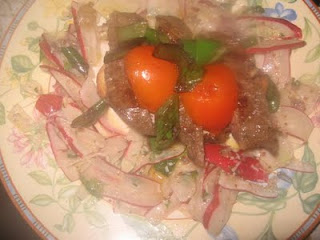
Anchovy are a member of the herring family anfound in large shoals all around the world. They are very strong tasting, but more salty than fishy in taste.
For a variation on this recipe, capers would be a good alternative.
At the moment I am back at work, sitting in Inebolu port, Northern Turkey, but had enough sense to bring away some photos of meals etc. with me to update the blog now and again.
My radish were quite small, but my mate Damiens were huge, about the size of a small carrot.
I have two types of radish at the moment, a red French Breakfast 3 type that is available in nearly all seed outlets, and a yellow french type called Jaune d'Or Ovale.
Many people don't like large radish, or find them too hot.
For this recipe I like that peppery kick, and the large size makes for better presentation.
For 4 people you will need about 4 large or, of the more usual size that you get in the shops, about 16.
INGREDIENTS
Enough radishes for people to be fed - 1 large of 4 small per person
50 grammes Parmesan cheese, grated
2 tablespoons lemon juice
4 tablespoons of Donegal Rapeseed oil.
Tablespoon chopped chives
1 clove garlic, finely minced
4-6 sustainable anchovy fillets, cut into small pieces
For the Anchovy HFW recommends fish-4-ever.com
Wash the radish. Using a veg peeler, slice into thin slivers as long as possible into a bowl.
Make a dressing using the garlic, oil, lemon juice, anchovy and grated Parmesan.
Pour the dressing over the radish and mix well.
Plate up and sprinkle over some chopped chives and a few shavings of Parmesan.0 -
Advertisement
-
Just back from Italy, so for food still thinking like that.
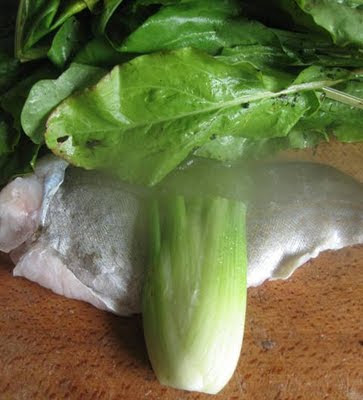
This dish is very simple, using Irish dairy produce to enrich an Italian style flavour.
Using milk to cook fish is not something I found in Italy, but in more Northern countries it's quite common.
The poaching in milk process enriches the fish, and gives it a more creamy texture.
You will need:
Filleted and pin boned pollack - enough for each person. Another sustainable white fish like whiting is also good.
1 fennel bulb - trimmed and finely sliced
2 small shallots
knob of cuinneog butter
enough milk to barely cover fish
Salt and pepper
Preheat oven to 180 deg centigrade
Grease the dish with a little butter
Arrange the fish fillets in a single layer
Sprinkle over the finely chopped fennel and shallot
Add salt and pepper
Pour over milk until the fish is barely covered
Cook for 20-25 minutes at 180
When the fish is done, the liquid can be strained off to make the base of a parsley sauce.
Serve with new-ish potato's with a carrot and fennel salad with a lemon based dressing.0 -
Ok took the plunge and bought the livers today. I havent opened the bag yet !! Ughhh.
However I ll get over the squeamish part of it as I love Pate.
I have googled for a few recipes but just wondering had anyone made it with a tried and tested recipe ? Or any hints in the making of the Pate ?0 -
I had a thread on this just a few days ago: http://www.boards.ie/vbulletin/showthread.php?t=20565241930
-
Thanks Faith. Perfect !0
-
http://istuffmyface.wordpress.com/2011/01/05/slow-cooker-pork-belly-confit/
Cooking this pork belly confit at the moment in the slow cooker. It's been in for 4 hours and I'm just waiting for it to cool down to put it in the fridge for a couple of days. I've just tasted a bit and it is delicious at this point and apparently gets better once it's been submerged in fat for a few days and then deep fried!0 -
http://istuffmyface.wordpress.com/2011/01/05/slow-cooker-pork-belly-confit/
Cooking this pork belly confit at the moment in the slow cooker. It's been in for 4 hours and I'm just waiting for it to cool down to put it in the fridge for a couple of days. I've just tasted a bit and it is delicious at this point and apparently gets better once it's been submerged in fat for a few days and then deep fried!
I deep fried some of this last night and it is the tastiest piece of meat I have ever eaten.0 -
Sound pretty amazing all right!0
-
Made Gordon Ramsay's twice cooked pork belly confit over Christmas - was lovely! Thinking of doing it for the Cooking Club when my turn comes up actually.0
-
Hi folks,
Making sweet and sour pork for the kids this evening.
Have the pork and sauce, out of a jar.
What is the best (and easiest way to make it)
Thanks.0 -
Advertisement
-
Put a little oil in a wok, or deep frying pan. Put the pan on a high heat on your stove. Cut the pork into bite-sized pieces and throw it into the pan - it should sizzle. Cook, moving the pan backwards and forwards to prevent sticking, until the pork is nicely browned on the outside. Add any vegetables you have handy, chopped or sliced into small pieces - peppers, onions, mushrooms, carrots would all work. Continue to cook until they're softened a bit, then reduce the heat, pour over the sauce from the jar, cook until it's hot, simmer for a short while to make sure the pork's cooked through, then serve with plain or fried rice, or noodles.0
Advertisement
